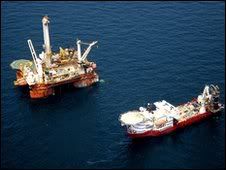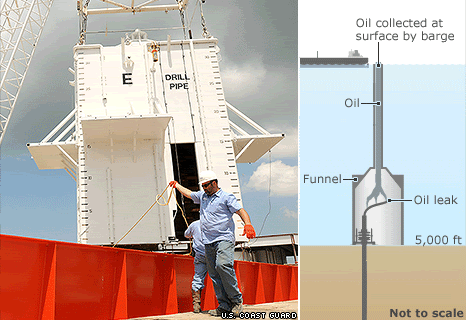

Engineers from oil company BP are scrambling to find a way to contain oil gushing from a well on the seafloor of the Gulf of Mexico.
BP has met problems with a containment box it tried to lower over the blown-out well in order to funnel the leaking oil to the surface.
Oil has been spilling into the Gulf at the rate of 210,000 gallons a day since a drilling rig exploded on 20 April.
Balls of tar have begun washing up on a section of beach in Alabama.
Bundles of absorbent material have been laid on the beach at Dauphin Island, Alabama, in an attempt to protect the resort area.
Samples of the tar balls have been collected to analyse them and confirm whether or not they come from the oil spill.
'Options'
A massive effort to contain what threatens to become a massive environmental catastrophe has been under way since the Deepwater Horizon rig sank two days after it exploded with the loss of 11 lives.
A sheen of oil began arriving on barrier islands off the coast of Louisiana last week, and crews have been laying inflatable booms, spraying chemical dispersants and setting fire to the slick to try to keep it from coming ashore.
The 98-tonne containment box had been the best hope to stem the flow of oil from the well.
The unprecedented plan was to lower it 5,000 ft (1,500m) by remote-controlled submersibles over the main leak and then funnel the oil by pipe to a waiting tanker on the surface.
But a build-up of crystallised gas inside the box blocked the exit at the top and the device had to be put aside on the seabed for engineers to ponder their next move.
"I wouldn't say it's failed yet," said Doug Suttles, chief operating officer for the BP, the company responsible for the clean up.
"What I would say is what we attempted to do last night didn't work," Mr Suttles told reporters in Robert, Louisiana, on Saturday.
"As we were placing the dome over the leak source a large volume of hydrates formed inside the top of the dome, requiring us to move the dome to the side of the leak point.
"The dome is currently sitting on the seabed while we evaluate options to deal with the hydrate issue. We believe that it'll probably take the next two days to look for opportunities to overcome this challenge."
These could include using hot water to heat up the hydrates at the ocean floor, or using hydrocarbons like methanol to thin them out.
It was hoped the box could help funnel 85% of the escaping oil but the technology has only ever been used a few times in shallow waters.
Meanwhile, a relief well is being drilled - considered a more permanent solution to the leak - but that is weeks from completion.
Although the rig was operated by Transocean, it was leased by BP, which is responsible for cleaning the 3 million gallons that have so far leaked, creating a slick covering about 2,000 sq miles (5,200 sq km).





0 comments:
Post a Comment